Text
Alright !
A nice anon asked me the other day about my writing software, and I gave out the name “manuskript” and like, realised that i really wanted to share more about it with you guys ! (I gain no money for that, i just really like that app ?)
SO, Manuskript.
First it’s free. So, yeah, nice ! Then :
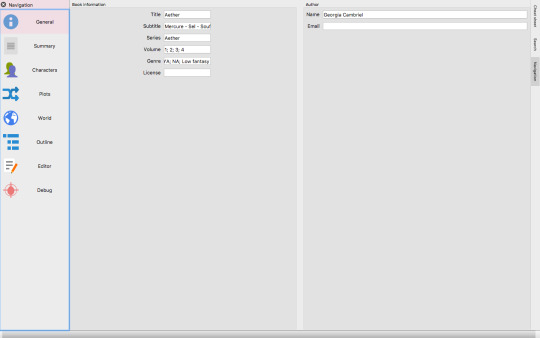

Parts to put your general infos and summary, with option to put different sized summary. NICE. Then I guess you’d like to keep tracks of your character ? Well good cause here :
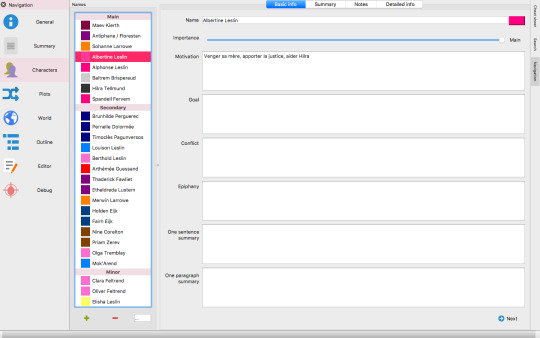
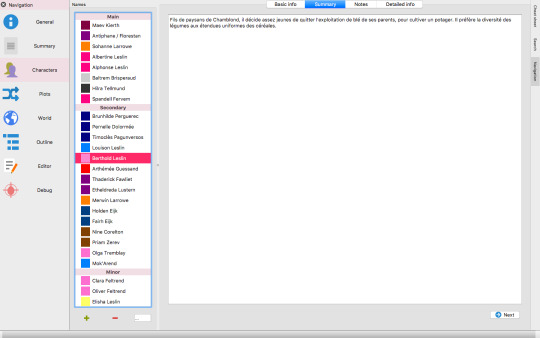
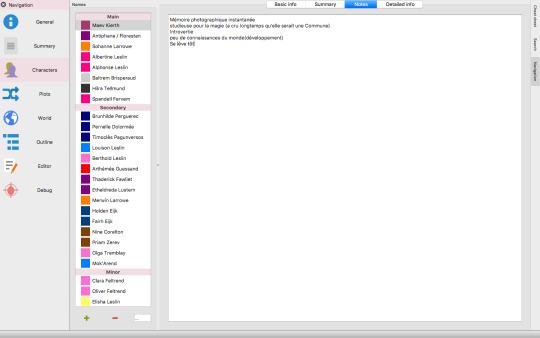
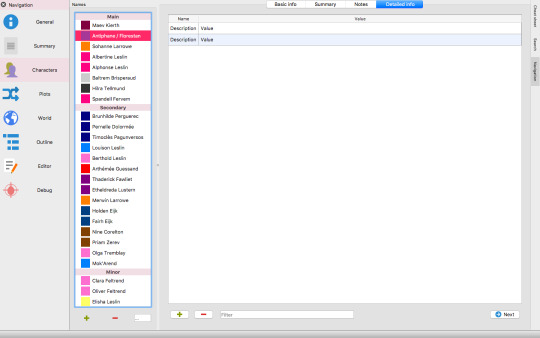
Sorted into main/secondary/minor for your convenience. You can chose colors for them which will be useful later… Mine is pretty empty cause I got all in my brain and forget to put it down here but see that last tab ? Perfect for a character sheet !
Then you’ve got plots, sub-plots, sub-subplots ? Here you go :
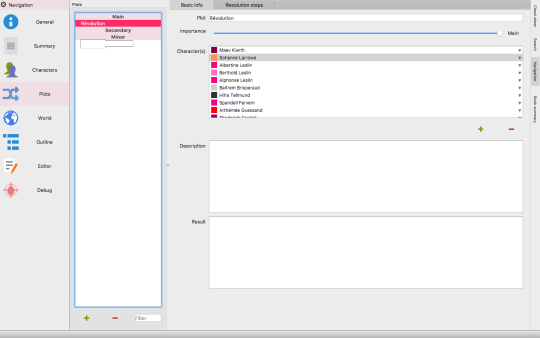
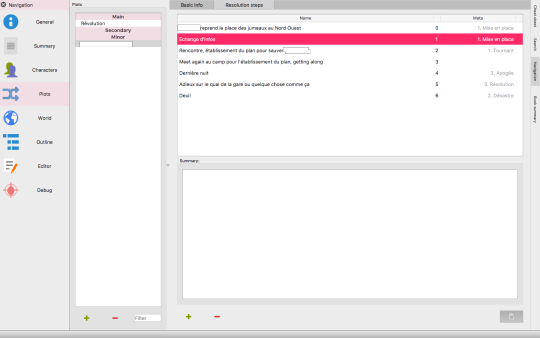
I did some censorship there, because I wouldn’t want to spoil you but see ? Organised in importance, general infos, characters part of the plot/subplot, then resolution steps. Also there’s a button on the right side so if you wanna have the book summary on screen you can. SO NICE.
Also I guess you may have some worldbuilding to do ? GOOD cause there’s a part for this too !

Here you can put all your worldbuilding stuff, under categories of your choice !
Now you want to do some plans for your writing ? put down chapters, parts ? guess what’s in the “outline” tab ;)

On your left, you plots and subplots. In the middle, your outline. You can also put a summary, one line or longer, set the POV, and the wordcount goal down there. HOW COOL.
What about ACTUALLY WRITING NOW ?

Here is the Editor with all parts open : outline on the left, data, cheat and search tab on the right, and that thing that let’s you keep track of things you put in References (in the data tab) through chapters, with POVS, down.
Note : You can chose also what appears in the outline bar : here i set it so that i have :
- progression percentage after categories, wordcount after chapters
- color of chapter icon indicates POV
- color of categories and chapters name indicate progression (red = not started or less than half [or two thirds ?] of goal, blue = half of goal or more, green = goal or more, orange = more than a third of goal above it)
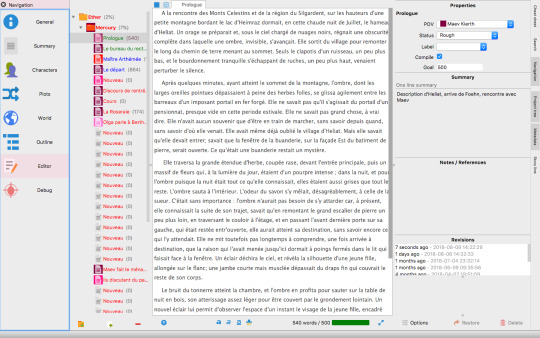
Of course you can chose which tabs are open. For example this is my usual set. Outline, data, nothing more

I don’t use much of the “Debug” part, but it’s a great way to keep track of things, and I guess you can do much with it that I don’t know about.
Tl; dr : THIS THING IS GREAT AND FREE SO YAY.
1K notes
·
View notes
Text
For those of you lying on your resumes about being proficient in Microsoft Office, time to actually get those skills. Jobs exams are becoming more popular. Companies are testing you to make sure you actually know your shit.
59K notes
·
View notes
Text
One common thing I see in fantasy is a single religion that exists (or, occasionally, one religion per species) where belief is a matter of degree rather than type. People may be more or less religious, but everyone is working off of exactly the same religious framework with no real variation. I think that this comes from the feeling that, a long time ago, religions were totally homogenous in their beliefs, and that in any given place there was only ever one religion that was being dealt with or known about, which isn’t the case in actuality. Here are some ways you should consider incorporating diversity within your religious worldbuilding:
Have multiple religions
Especially if you have an urban setting or a setting where there are multiple cultures, have multiple religions being practiced in the same place
Don’t resort to “basically Christianity” and “basically generic paganism”
Have sects based on regional divides
Have sects based on external political divides
Have sects based on interal religious divides
Have your religion change over time
Especially with branching paths that end up with different versions of an old religion
Have different religions include different degrees and conceptions of public and private practice
Have different views of practitioners of a different religion and practitioners of no religion
3K notes
·
View notes
Text
Per dirti che ti amo in tutte le lingue del mondo
Afrikaans: Ek het jou lief
Albanese: Te dua
Arabo: Ana behibak (verso un maschio) - Ana behibek (verso una femmina).
Armeno: Yes kez sirumem
Bengalese: Ami tomake bhalobashi
Bielorusso: Ya tabe kahayu
Brasiliano: amo você
Bulgaro: Obicham te
Cambogiano: Soro lahn nhee ah
Catalano: T’estimo
Cherokee: Tsi ge yu i
Cheyenne: Ne mohotatse
Chichewa: Ndimakukonda
Cinese: Cantonese Ngo oiy ney a
Cinese Mandarino: Wo ai ni
Comanche: U kamakutu nu
Coreano: Sarang Heyo oppure Nanun tangshinul sarang hamnida
Corso: Ti tengu caru (verso un maschio) - Ti tengu cara (verso una femmina)
Creolo: Mi aime jou
Croato: Volim te
Ceco: Miluji te
Danese: Jeg Elsker Dig
Ebraico: ani ohev otach (da uomo a donna) - ohevet Otach (da donna a uomo)
Esperanto: Mi amas vin
Estone: Ma armastan sind
Etiope: Afgreki’
Faroese: Eg elski teg
Farsi: Doset daram
Filippino: Mahal kita
Finlandese: Mina rakastan sinua
Francese: Je t’aime
Gaelico: Ta gra agam ort
Georgiano: Mikvarhar
Greco: S’agapo (Σ’αγαπώ)
Gallese: ‘Rwy’n dy garu di
Giapponese: Aishiteru
Hawaiano: Aloha Au Ia`oe
Hindi: Hum Tumhe Pyar Karte hae
Hmong: Kuv hlub koj
Hopi: Nu’ umi unangwa’ta
Islandese: Eg elska tig
Indonesiano: Saya cinta padamu
Inuit: Negligevapse
Inglese: I love you
Irlandese: Taim i’ ngra leat
Italiano: Ti amo
Latino: Te amo
Lettone: Es tevi miilu
Libanese: Bahibak
Lituano: Tave myliu
Lussemburghese: Ech hun dech gaer
Macedone: Te Sakam
Malese: Saya cintakan mu / Aku cinta padamu
Maltese: Inhobbok
Marocchino: Ana moajaba bik
Olandese: Ik hou van jou
Persiano: Doo-set daaram
Polacco: Kocham Ciebie
Portoghese: Eu te amo
Rumeno: Te iubesc
Russo: Ya tebya liubliu (Я тебя люблю)
Scozzese gaelico: Tha gra\dh agam ort
Serbo: Volim te (Волим те)
Setswana: Ke a go rata
Sindhi: Maa tokhe pyar kendo ahyan
Sioux: Techihhila
Slovacco: Lu`bim ta
Sloveno: Ljubim te
Spagnolo: Te quiero
Swahili: Ninapenda wewe
Svedese: Jag älskar dig
Svizzero-tedesco: Ich lieb Di
Suriname: Mi lobi joe
Taiwanese: Wa ga ei li
Tahitiano: Ua Here Vau Ia Oe
Tamil: Nan unnai kathalikaraen
Tedesco: Ich liebe dich
Tailandese: Phom rak khun
Tunisino: Ha eh bak
Turco: Seni Seviyorum
Ucraino: Ya tebe kahayu
Ungherese: Szeretlek
Urdu: mai aap say pyaar karta hoo
Vietnamita: Anh ye^u em (Verso una donna)
Yiddish: Ikh hob dikh
Yoruba: Mo ni fe
Zazi: Ezhele hezdege
Zuni: Tom ho’ ichema
6K notes
·
View notes
Text
how to self teach a new language
have contact with this language by hearing it on movies, tv shows and music. this will help you with your pronunciation skills and with your vocabulary
learn vocabulary and grammar at the same time
read kids books and translate what you don’t know. it might be hard at the beginning, but keep trying
speak to yourself will help you like crazy. I like to pretend that I’m acting or that someone is interviewing me hahah see the magic happens
READ AND WRITE. this is as important as speaking. It used to be so hard for me to write in English and I felt awful because I could actually speak very well. But my writing skills were just a lower level than my speaking level. Thankfully it’s getting better with practice.
try to study a little everyday. if you don’t have time to do so, watch a movie or something, but have this contact with the new language at least once a day
be persistent because the processes of learning a new language can really piss you off. sometimes you will understand nothing and that will drag you down. the difference is to keep pushing until it doesn’t bother you anymore!
9K notes
·
View notes
Text
Teachers: Wikipedia is very unreliable *Hands out 25 year old textbooks instead*
558K notes
·
View notes
Text
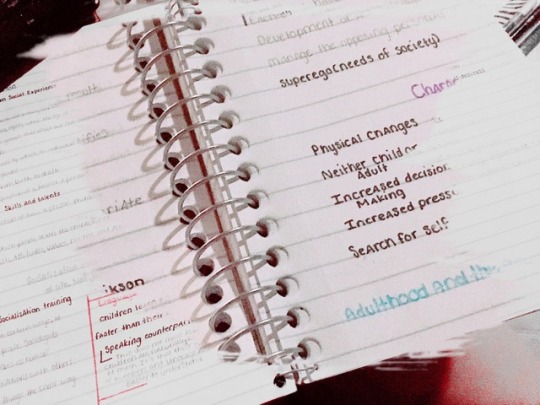
I barely ever post anything of my own on here, so here's a glimps of my sociology work! I've been feeling very motivated lately, and it's actually hard for me to show up to class lately. I'm trying to get better and I tried my best to keep going this week but ended up sick.
0 notes
Text
Creating Superstitions
. It’s related to JudasHey everyone, Abby here! Seeing as today is the famous “Friday the 13th”, I wanted to post something that would go a bit with the theme: superstitions and how to make them. Let’s jump right in!
What is a superstition?
According to Merriam-Webster, a superstition is “a belief or practice resulting from ignorance, fear of the unknown, trust in magic or chance, or a false conception of causation”. Essentially, it’s everything you’ve ever heard about mirrors and black cats.
Here is a short list of common superstitions in the modern world:
the number 13
black cats
breaking a mirror
walking under a ladder
throwing salt over your shoulder
opening an umbrella inside
And those are just a few. You’ve likely heard of at least one of these, especially from your most superstitious friends. Usually they have to do with luck or fate, or sometimes even religion.
Do I need superstitions in my world?
Nope! But if you’re currently in the world-building phase and you feel like it could use a little more depth, superstitions might be helpful. They could also be used as symbolism throughout the story.
How would I create a superstition?
Well, they can honestly be born from pretty much anything. All it takes is an idea and a backstory, and from there you can pick and choose which characters believe in it. Backstories are seriously important in creating your superstition as they’ll probably play a role in who really believes in them. Here are a few quick examples of superstitions’ backstories.
the number 13. This one is of Catholic origin. Judas Iscariot, the disciple who betrayed Jesus in the Bible, was 13th to sit at the table during the Last Supper.
black cats. Black cats are associated with many things, but the most notable origin I could find was the Middle Ages. “Normans and Germanic people believed that, like the black raven, a black cat was a sign that a death would soon occur.” (x)
breaking a mirror. Common thought is that any superstition involving a mirror came to be when early humans first saw their reflections in a pool of water. They may have believed that the image was actually their soul rather than their reflection and causing it any sort of harm would risk injury to the actual person.
There’s a lot of history in superstition. When creating yours, think of the logic used at the time. What did the people believe, and what were they most afraid of? Use questions like these in creating yours.
So, that’s all I’ve got for today! If there’s anything you want to see me talk about in my next post, please don’t hesitate to leave a message in my ask! UNtil next time, much love! <333
576 notes
·
View notes
Text
Experiment with political systems
Sure, having a king/queen is simple, but have you ever tried:
Democracy
Multiple nobles and they all have the same amount of power (lot of conflict potential)
You can become ruler by defeating the current ruler in a fight
The merchants run everything
A noble and a parliament rule
The most intelligent people rule
…
There are thousands of possibilities, be creative!
29K notes
·
View notes
Text
My favourite Strange Superstitions and Beliefs
1. Ringing Bells - During the rein of Queen Elizabeth, it became popular to ring bells to ward away evil spirits, especially those at the foot of the bed as it was said to frighten them away. They were also rung during prayers to guide departed souls.
2. Curse of the Opal Stone - Some people believe opals are evil and unlucky. The superstition stemmed from the best selling novel ‘Anne of Geierstein’ by Sir Walter Scott in 1829 where Lady Hermione was falsely accused of being a demon as she dies shortly after a drop of holy water accidentally falls on her opal jewellery and changes its colour. This book had such an effect on the image of the Opal that shortly after its publication, the Opal market crashed and Opal prices dropped by 50%. Some say it is only bad luck to wear opals if you were not born in October.
3. Counting Crows - Apparently it was once thought that counting crows flying overhead could tell one’s fate. “One’s bad / Two’s luck / Three’s health / Four’s wealth / Five’s sickness / Six is death.”
4. Eye twitches - Though there is not much information about how this English superstition was idealised, it is said that in one of your eyes twitch, you are bewitched.
5. Gravestones - If you align your gravesite (beforehand!) north-to-south you’re a witch.
6. Domovoi - A common Russian superstition is that one must never shake hands, kiss, sleep or sit near a threshold such as a door. Thresholds are where brownie-like creatures known as domovoi dwell and kissing or shaking hands is regarded as an offensive invasion of their space.
7. Yellow - In Russia, superstition people believe yellow to be a sad and unlucky colour.
8. Candles - In a candle blows out by itself, especially during rituals, it is a sign that evil spirits are near.
9. Chills - If you get a sudden shiver or chill, it is a sign that someone is walking over your eventual grave.
10. Sparrows - are said to carry the souls of the dead and it is unlucky to kill one.
15K notes
·
View notes
Note
Hi, I hope this is alright: I’ve got a story I’m writing, but I’ve practically given up because I can’t decide what happens next. I don’t have an ending. I’m barely in the beginning. But I can’t think of anything that works! I’ve been at it for months—maybe this, maybe that, maybe these?? Little tiny ideas that never fit. I feel like I’m not smart enough to put a structure together, and everything I try is awful and just makes me more stressed. I love this work. I don’t want to let it go. Help?
You are 100% smart enough to put everything together, and it is probably not as awful as you think it is. It sounds like you need to identify the direction your story is going, and building an outline/timeline might help you.
First, write down all of your little ideas down. Bullet-point them in a list, put them on Trello cards, put them on paper index cards, whatever floats your boat. Just get them down. Arrange them in a vaguely chronological order if you can, but it doesn’t matter if you can’t.
Now, answer these question about your main characters:
What does your character want?
What is preventing your character from getting what they want?
What internal changes does the character need to make in order to achieve their goal?
By the end of the book, where will the character be in their journey of internal change?
Answering these questions should give you a Point A and a Point B – where the character is at the beginning of the book, and at the end. Take your list of ideas, and ask yourself: can this be weaved into your story or tweaked a little so it helps my character get from Point A to Point B?
For example:
My character wants to escape their prison, but a dragon is guarding them. However, they believe that they’re too weak to defeat the dragon, and need to be rescued. By the end of the book, they have realised that the only person who can save them is themselves.
Maybe one of my ideas is that my main character saves a knight who has come to rescue them - I can use this idea to show my main character realising that they’re not so helpless after all.
I would also highly recommend looking at story structure! At this point, I wouldn’t overthink it - just take a look at a few different story structures (they pretty much all say the same things in different ways), and map out a few turning points in your story to guide you - e.g. at 50%, my character discovers that the dragon guarding her isn’t just a dangerous beast, then at 75% there’s an all-is-lost moment where my character is separated from all her allies.
Finally, don’t worry too much about the first draft. Get the story down on paper, then come back later with the bigger picture in mind to make it better. Good luck, and I believe in your ability to put together an awesome story!
155 notes
·
View notes
Text
tips for writing bilingual characters
there are different types of bilinguals
the All Around: speaks, reads, and writes both languages pretty well
the Conversational: one language is stronger than the other; can speak the other language a lot better than they read/write it (a lot of kids of immigrants are this type)
the High Schooler: understands what’s being said to them in the other language, can’t really speak it
don’t have your characters randomly drop words from their other language mid-sentence around people who don’t speak it lol
languages are a mindset thing. like personally if i’m around english-speakers, i’m speaking english and i don’t really switch to my other language (which is portuguese)
so like if you’re writing a bilingual character who speaks spanish and have them say something like “hey chad let’s go to the biblioteca” to an english speaker i’ll probably spend 5 minutes laughing and then close your story lmao
exception: the character is speaking in their weaker language and forgot a word (”where are the…? uh… llaves…. keys! keys, where are they?”)
otherwise really the only time your character should be randomly switching languages mid-sentence is if they’re talking to another bilingual
like i don’t speak spanish but i’ve legit never heard a spanish speaker say “ay dios mio” to gringos lmao
conversations between two bilingual people can take a few different forms:
Pick One: they pick one language and kinda stick with it for the whole conversation (a conversation i might have with my portuguese-speaking mom: ”you okay?” “yeah, i’m good. how’re you?” “i’m fine, but your dad-”)
Back-and-Forth: someone says something in one language, the other person replies in the other (”tudo bem?” “yeah, i’m good. how’re you?” “tou bem, mas o seu pai-”)
Combo: they speak a combo of the two languages, a popular example being spanglish, though basically every bilingual has their own combo language (”tudo bem?” “sim, tou bem. how’re you?” “i’m fine, mas o seu pai-”)
when in doubt: just ask a bilingual to look at your stuff and tell you if anything sounds weird
65K notes
·
View notes
Text
Guide: WQA's Guide to Internet Research
I get a lot of Asks from people who say they Googled their topic but didn’t find anything. Then I Google it and find a ton of resources. I prefer to think that this is because internet research can be daunting, so I am putting together this little guide in hopes of making internet research a little easier.
Step One - Reduce your topic to the fewest number of words you can and try Googling it. For example, if your protagonist is a fireman, try Googling:
Fireman
Firemen
Step Two - Put the information you need into question form and Google it. For example, for your fireman character, you will need to know what it’s like to actually be a fireman. Try Googling:
What’s it like to be a fireman?
What does a fireman do?
What is a fireman’s life like?
Step Three - Think of different statements that describe the information you’re looking for. For example, if you want to know what it’s like in a firehouse, try Googling:
Life inside a firehouse
Fireman daily routines
Step Four - See if there are any alternative words you could use to describe your topic and Google those. For example:
Fireman/Firefighter
Firehouse/Fire Station/Fire Department
Fire Truck/Fire Engine
Step Five - Search for personal points-of-view by searching for blogs, interviews, forum posts, and experience essays. Using a fireman as an example, you could search for:
“Fireman Blog”
“Interview with a firefighter”
“My experience as a firefighter”
You can also search for an IamA (I am a…), which is a form of Ask Me Anything on Reddit. IamAs are posted by people with interesting jobs or careers who open themselves up to questions from other Reddit members. Reading through an IamA on your topic (if there is one) is a great way to learn from the personal point-of-view of an expert.
Step Six - Search for your topic on YouTube. I know it sounds crazy, but just do it. You never know what you might find. Case in point:
“Fireman” brought up “Life of an FDNY fireman” as the 12th result.
“What does a fireman do” brought up “You can be a firefighter” as the second result.
“Life inside a firehouse” brought up “Life in the Firehouse-WFRV” as the first result.
Now, Let’s Talk About Results:
When you type a search term into Google, you’re likely to get millions of results. That can be very daunting if you’re not entirely sure what you’re looking for. So, how do you wade through all of that information to find what you’re looking for?
To start with, you should be able to find enough information to help you within the first three pages of results. As you read down each page of results, just ignore things that obviously don’t pertain to your search, and when you see something that might pertain to your search, right-click on the result and then left-click “open in a new tab.”
Let’s take a look at what comes up for “fireman”:
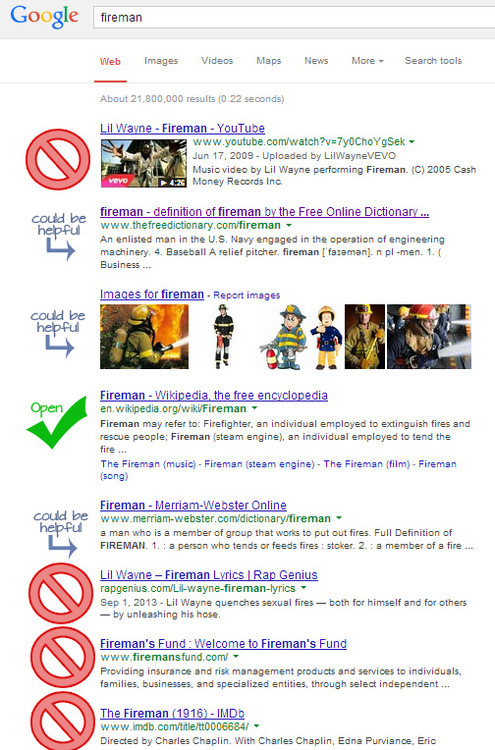
Clearly, we’re not looking for a Little Wayne song, so we can ignore that. Definitions might offer helpful information, but you probably already know the definition of your topic. Images can be helpful, but ignore them unless you need a visual. Wikipedia links, though not always accurate, are always worth opening. The article will give you a helpful overview of the topic—just make sure to double-check any facts you note down. So, one result for the first page isn’t bad. Pages two and three offered a few more worth opening.
Now, let’s look at the results for “interview with a firefighter”:

Any search for a career plus “interview” is likely to bring up tips for people who are interviewing for a job in that career. In this case, most of the results on the first page were interviewing tips for prospective firefighters. However, there was one helpful hit—a video interview with a firefighter. That is exactly what we were looking for, so we’ll open up that tab. Once again, pages two and three had a few more links to actual interviews with firefighters as opposed to interviewing tips.
Once you have three to five tabs open, you can start looking through each one to gather information on your topic. You can jot the notes down in a notebook, or you can open up a Notepad document (just be sure to save it a lot) and jot down your notes in there. It is also helpful to print out articles or interviews if you can, and then use a highlighter to keep track of important information.
The three most important things you can do when doing internet research are:
1) Don’t let yourself get overwhelmed by all the information. Just take one result at a time and keep going until you have enough helpful information.
2) Be patient. While you should be able to find a lot of helpful information within the first few pages of results, sometimes you may need to look at several pages or try several different search terms.
3) Don’t give up! Research is important to your novel, and you’re really the only one who knows exactly what information you need. It may take hours or even days, but stick with it until you find the information you’re looking for. Sometimes a new search term to try will hit you out-of-the-blue, and that’s the one that brings up all the information you could want.
Good luck and happy researching!
5K notes
·
View notes
Text
Research Tips
Researching is easy. It’s also incredibly difficult. Fortunately, there are a few tricks you can use to find better resources.
1. Use Google to Your Advantage
Having good Google-fu means knowing how to narrow down your search to find the best resources possible. Fortunately, Google gives you a lot of tools to use to help narrow down your searches.
First of all, trimming your search down to ONLY .edu or .org resources can be very helpful. (A lot of “.com” sites are purely for profit, and may not have the best information. And “.edu” sites are usually from universities.)
To do this, simply include this before your search -

You can also use this to search specific websites for information. For example:

PDFs are also great resources for information - even better, they’re easy to print off, which can be especially helpful if you’re searching for worksheets. You can specifically search for PDFs by including this before your search:

Quotation marks denote specific phrases - “keyword” so always use this if you’re searching for something very specific. And on that note…
2. Be Specific
If you just search for “Roman Buildings” you’re going to get a wide, wide range of results. If you search “Roman Architecture” that will narrow things down. If you search “Ancient Roman Architecture” it will narrow it down even further. And the ultimate would be something like, “5th Century BCE Roman Architecture,” though something that precise may be unnecessary if you just want a general idea.
3. Lists, Lists, Lists!
If you’re searching for anything that may have multiple categories, preface your search with “list of…” 9 times out of 10 there will be a Wikipedia page for it, which will give you direct access to a TON of information.
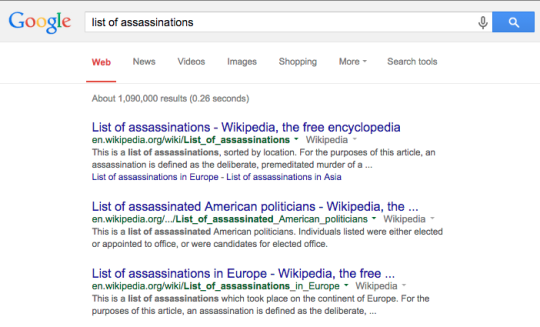
Bingo Bango. And on THAT note…
4. Learn How Wikipedia Works
If you see a page that’s almost what you want, but not quite, scroll down to the See Also section. Click around until you find what you need.
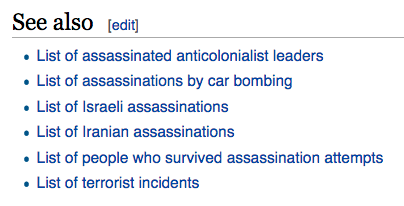
5. Scholar.Google.Com
Great for if you’re searching for higher end resources.
4K notes
·
View notes
Text
How to Start an Assignment
Please DO NOT waste time staring at a blank word document wondering how to start your introduction. Follow these steps to break it down, and plan + start your assignment efficiently.
Highlight the key information on your brief/marking criteria (word count, structure, what to include etc.)
Open a word document. Immediately save it and name it ‘*class name* assignment draft’.
Set up the basic assignment structure. Use the built in tools in Microsoft word to create a cover page, contents page and reference list. Add automatic page numbering and a header/footer if necessary.
Using your assignment brief, structure your assignment using headings and subheadings. Use the ‘Styles’ on the home tab in Microsoft word for all headings (they will then be automatically included in your contents page). Remember to number your sections. If you haven’t been given specific topics/headings, don’t skip this step. Use generic headings like ‘Introduction, Point 1, Point 2, Conclusion, Discussion etc.).
Allocate an approximate word count to each section so you know when to stop (as a guide: the total word count divided by the percentage of the grade allocated to that section)
If you already have some ideas, start listing them in bullet points underneath the headings. If not, flip through notes or your textbook and start adding things that might be relevant into each section.
Always start referencing/include citations as you go along, even in the notes! Do not leave it until the end because you will definitely have forgotten where the information came from.
When you have enough content, start turning notes into paragraphs.
Allow enough time for proofreading, ideally by someone else! You can easily lose 10% of the marks available by making silly mistakes and its much harder to spot your own.
There will be a part 2 of this post with tips for how to write the best assignment possible (coming soon)
3K notes
·
View notes



